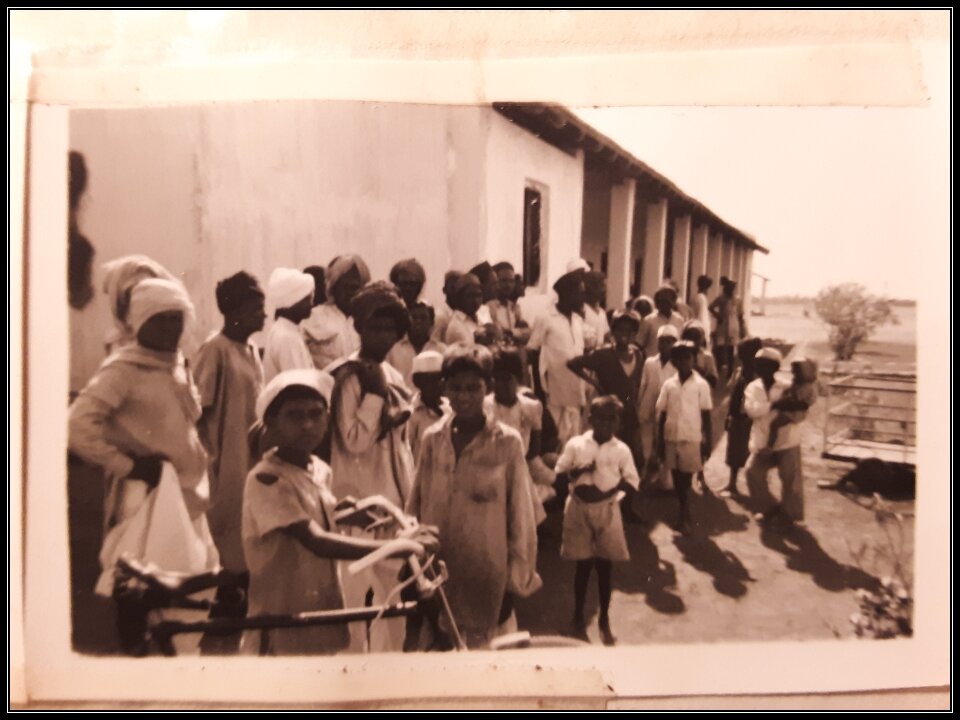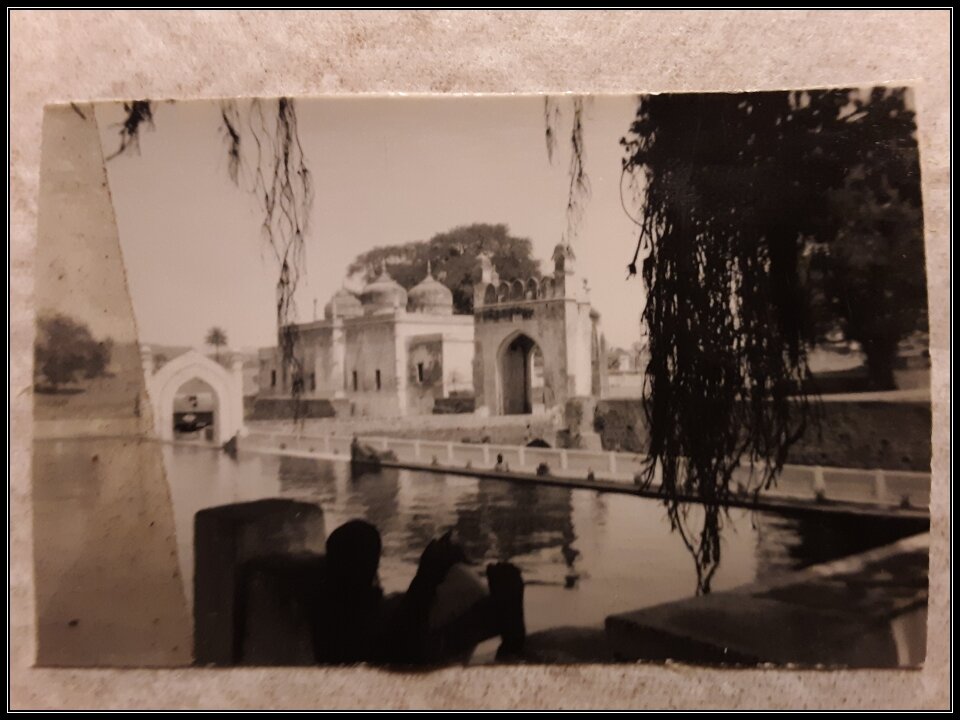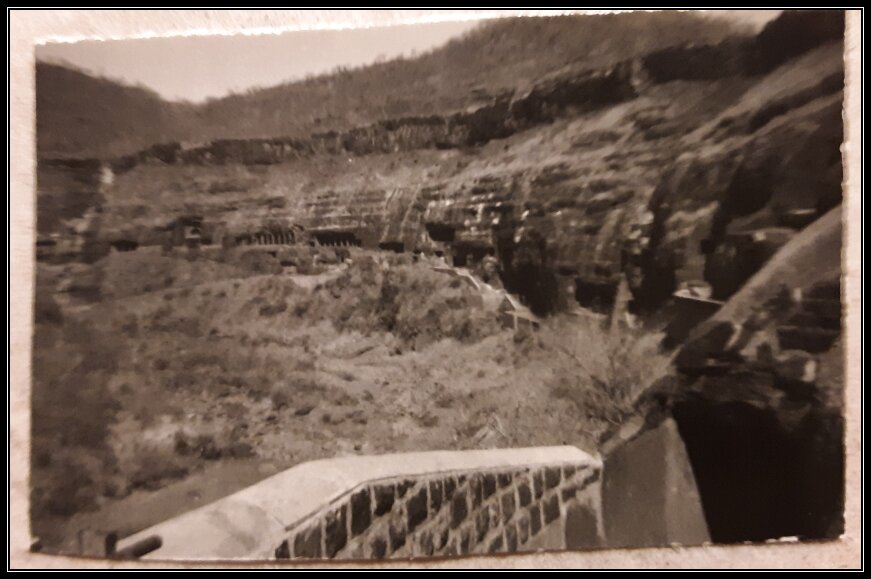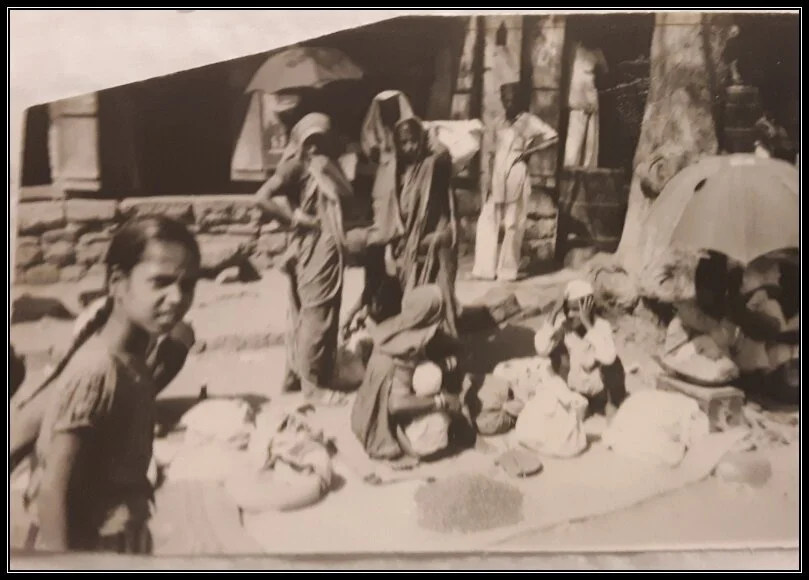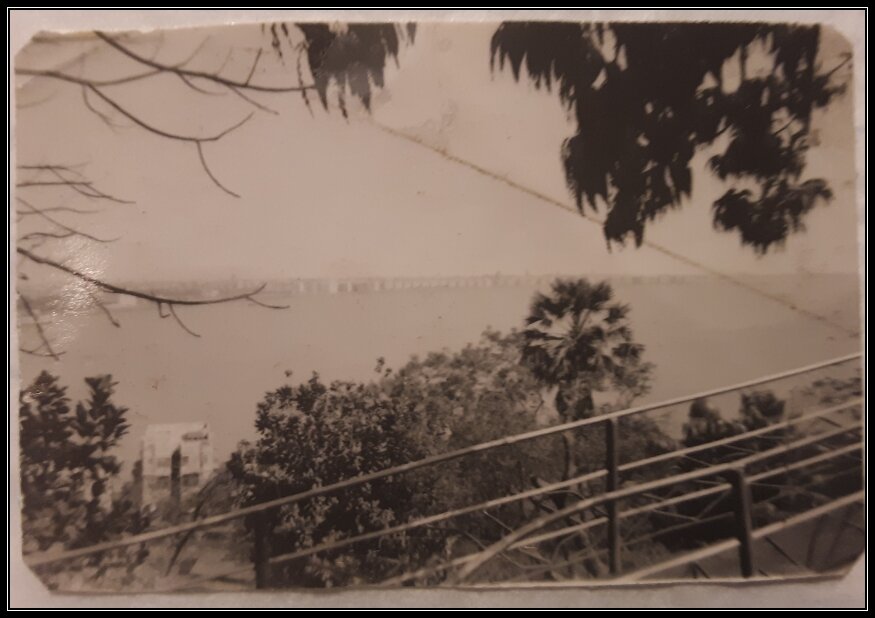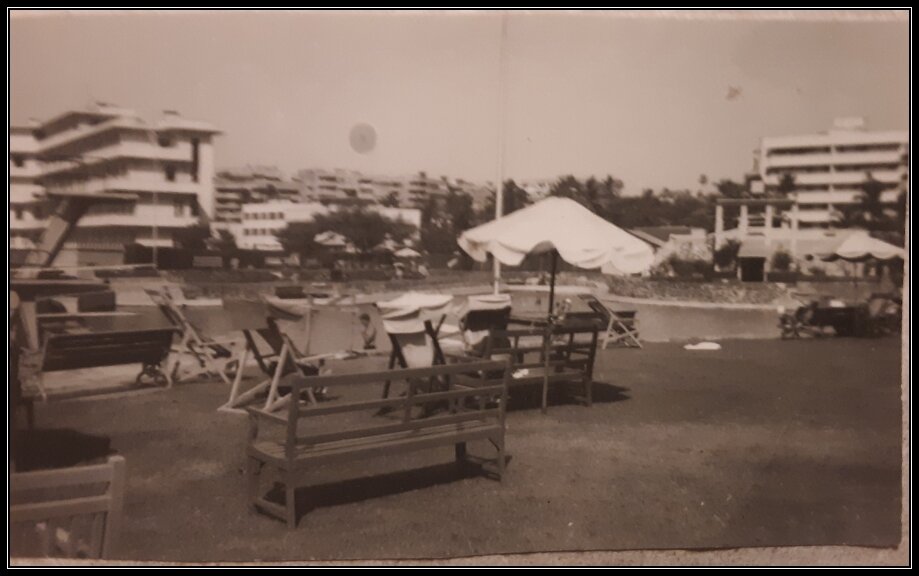The Big Trip-part 1v
In Bangalore we met Bill Rutter again. That man really travels. Bangalore looks like a highway town in Mid-west U.S.
And we tempted fate the next day - Friday, the 13th - and took a Deccan Airways plane (they are notorious for their accidents) and flew to Hyderabad. We had to go back through Hyderabad to ge where we were going, which was Aurangabad.
These were some of the people at the airport to watch the plane take off. And these are more Hyderabad pictures. We were just there for the afternoon, but we had to go to the fort again so that Alan could see it, since he wasn’t with us for the first time.
This is me (with borrowed sunglasses)
and my two travelling companions, Mannie and Alan, with straw hats purchased in Ceylon.
And here is your truly and Alan Campbell, cameras in hand - still at Golconda Fort;
and another view of the main hill.
Dan Bailey was in Bombay when we arrived in Hyderabad the second time, but we called USIS Library there and commandeered a car. We could find no place to eat lunch except the railway restaurant which wasn’t doing much business. They had nothing edible so we bought canned soup, pork and beans, salmon and fruit and had them open the cans and serve it to us. It was almost our best meal on the trip.
We went down in the shopping district near the railway station to look for pillows, as we were going to take an overnight train ride again to Aurangabad and didn’t relish another night with only a sheet for comfort. While we were at it I bought a colorful cotton padded “mattress” for a few ruppees and we climbed aboard the train with a bundle of pillows, etc.
I had a little experience that night on the train that cured me in advance of any inclination I might ever have to travel alone on Indian trains. The sleeping cars will bed four, usually. Alan, Mannie and I had to share ours with another person, and this time he was an Indian Army fellow with a rifle in hand. Alan had a little tiff with him when we first got on the car. Other passengers rode in our car until bed-time at 10:00. When we got on the Army fellow had his bed roll all spread out on one lower bunk and the two boys sat down on his bedroll and rifle.
“Why don’t you put your rifle up on the top bunk?” asked Alan. “Oh, it’s all right here,” he replies casually. Alan croaked, “Well I don’t want to sit on a rifle! and the guy put it under the bunk.
All went well, and we finally were able to go to bed. There is a little three square feet bathroom where one can dress. I decided to sleep in the bunk above the Sgt. (We called him Sgt. York.) so that I could see the two boys across from me and he couldn’t see me from below. The top bunks are bolted to the walls with about a two inch space between them and the walls.
About 4:00 in the morning something woke me up. It was pitch black and I couldn’t see a thing. Just being awake in the dark of a speeding train was a little frightening, and I felt very much alone, knowing the two boys were sound asleep. Then I thought I felt something prodding the bottom of my bunk. “It’s just my imagination, “ I thought and lay there waiting to see if I was right. Again I felt it, but still waited. Then my head on the pillow lifted right off the bunk and I surreptitiously moved down so that my friend, Sgt. York, below me could not reach the pillow through the crack at the top of the bunk. And then he reached through the crack at the side and very stealthily began pulling my sheet down. I don’t know whether he knew I was awake. I somehow didn’t want him to know he had me frightened. I pulled the sheet in around me and went through minutes more of the insistent prodding. And then he got the edge of the sheet again and I let him pull until it was taut over my body and when he gave a last tug, I suppose to free the other side I had pinned under me, I could stand it no longer and I sat up and yelled for Alan. He woke immediately and said, “What’s the matter? Are we there,” “No. But I want you to turn on the light.” So he struggled out of his top bunk and couldn’t find the light. So he opened the bathroom door where the light was on. He thought I had a bug in my bed and I quietly told him in a slightly shaking voice that Sgt. York had been bothering me. The Sgt. was lying there stiff and straight with a towel covering his head and with the light on and Alan back up in his bunk where he could keep an eye on him - nothing happened. We arrived in Hyderabad about 5:00 and detrained. The boys still thought it must have been my imagination until I told them the whole story.
I’ll always wonder just what the point of such carrying on was. I suppose he figured that this American woman who was travelling around with two guys on Indian second class cars could be nothing but a loose woman. Could be it was his way of saying, “Come on down.” I kept thinking of his rifle…and you hear lots of wild gory tales about things that happen on trains, etc., and Indian people say women should never, never travel alone.
A car was there to meet us from the Hotel where we had made reservations. We thought that was really wonderful, especially since we hadn’t told them how we were arriving, or hadn’t asked them to meet us. It is so nice to be taken care of and not have to worry over luggage and fight with coolies and taxi drivers.
The hotel there is one of the Nizam of Hyderabad’s projects and it is a lovely building. The grass and trees and everything that once was green is now all dried up. The woman who runs the place said that this is the first time that has happened in the 12 years she has been there. The whole area is parched.
We were about the only guests. Aurangabad is way out in the middle of nowhere. The only things of interest are the caves nearby; they are world famous and many people from around the world fly over from Bombay to see them. We hired a taxi for Rs. 22/- to see the Ellora Caves that day. It was very hot and our driver smelled heavily of musty rose hair oil. The landscape was parched and barren. We passed one hill with a fort built on top - Duladabad.
The caves are fabulous. You aren’t supposed to take pictures, but Mannie sneaked in a few. They are carved out of solid rock - 30 or 40 different caves, some Buddhist, others Brahminical or Jain. The most spectacular work is the Kailasa temple, which is carved inside a huge cave, open to the sky. I can just imagine the ancients sitting down on their haunches up there on solid ground with a hammer and chisel, starting to chip away at the rock. Most of the caves are dug in from the wall face of the hill, but this one was dug down from the top. You can see from these two pictures that even the façade of the caves is highly ornate. The immensity and splendor of the Kailasa temple cave is out of the reaches of my powers of description. Around the bottom of the temple, itself, is a whole panorama of huge animals.
A lot of work had been broken away over the centuries and some carvings are rather obscure from erosion. At one time water must have gotten into the cave and you can see where the water line has eaten away almost whole pillars. The carving work was done about the time of Christ.
Nehru once said that if he came to India just once and was allowed to see two things, he would choose the Taj Mahal and the Ellora caves.
Mannie Silberstein
Alan Campbell
On the way back from the caves we stopped to see Aurangzeb’s tomb, patterned after the Taj Mahal. Although it looks somewhat like the Taj Mahal at Agra, when you have seen the real McCoy, this one looks shoddy. It is much smaller and altogether inferior. We called it “the poor man’s Taj Mahal.”
And then we stopped at a “water mill” -a big tank full of water with some interesting gardens and buildings around it. This is a picture of Alan sitting on the edge of the tank reading “Murray’s Guide Book to India, Pakistan and Ceylon.” We took the book with us on the whole trip and every time we would come to a new area we would read all about it in the guide book.
The always present vendors and beggars were at the gate. And there are always people loafing around, sitting in the shade. It seems that all over India most of the people seem to be sitting around on their haunches talking or staring into space. Nobody looks as though they are in a hurry or seems to be engaged in making a living, except for the merchants.
Here are the vendors ….
and the loafer.
Here is an incident we have dubbed “the pice incident”. These little kids were gathered around us and, as we were leaving they all stuck out their grubby little hands for Baksheesh. the little boy third from the right was so cute - he reminded me of Billie. So I decided to clean out the small coins in my purse and give them to the kids. I gave them each a few annas and gave some pice (three to an anna) to the littler ones. They looked abashed and held out their hands as much as if to say, “We don’t want these. We want annas.” So I took them back and left them nothing. Aesop would make a fable with a moral out of this, I’m sure.
We got back to the hotel for lunch and slept all afternoon. The next day was Sunday and we had to face a much longer trip to see the Ajanta Caves. I refused to go with the same smelly driver, so we hired a newer looking car with a driver who smelled only slightly better. This one cost Rs. 75/-.
After a long tortuous ride, we arrived at the caves, which looked from a distance much like the others. There are not so many carvings in the Ajunta Caves, but the walls are covered with ancient painted frescoes. They are disappointing, after having seen Ellora. The frescoes were so peeling and in such bad condition, and the caves were so poorly lit that you really couldn’t see much. We mostly went into dark, cool caves that were half finished and took naps; and then moved on out into the scorching heat and into another cave for a cool nap.
It turned out that our newer car was in bad condition and it stopped several times on the trip back to the Hotel, overheated. We stopped at a guest house for lunch in the town of Ajanta. The colorful Banjari women were in town for their weekly bargaining wearing their crude jewelry on arms, ears, nose and forehead.
At one place where the car stalled, I decided to walk up the road until they got it fixed and caught up with me. I walked and walked and walked until I almost got sun-stroke, and then over in a field I saw a couple of little kids watching some water buffalos. They were passing out water to the people who trudged by om their way back to their villages from the city of Ajunta, where they had gone for marketing. The little girl was about eight - an animated, winsome little thing who hopped to and fro shooing the goat away from their little pile of belongings and dipping water from the earthen jug for the weary travelers, who gave her a few pice in return for the water.
The little boy was a few years older. He mostly sat with a tick in his hand, alternately watching me and the buffalos. The girl jibbered and jabbered at me in an unknown language. I only understood the word ‘pani’ (water). She didn’t understand my not wanting water. I just sat at the foot of a tree in the shade and talked to her in English and she talked back at me in her language and we smiled at each other. I hadn’t taken anything with me except my camera, so I couldn’t give her any money…..and I didn’t even think to take a picture!
After a while a woman came walking over the field from the rise of a hill with a giant oil can full of water on her head. She was the mother of the children. I guess she carried the water from a river down below the hill. She asked about me, and the little girl looked like she was telling her, “I don’t know who she is. She just came walking down the road from that direction and came and sat down and she doesn’t want any water.”
The woman motioned to me, asking if I wanted to lie down. I said, “No thanks, I’m quite happy here.” She understood, I guess, and they went on about their business - opening a little can full of milky looking glop, like curds, and untying a rag full of chappatis (round flat bread cakes). They sat down there on the furrows of the field to eat.
These are some of the Bangari women we saw along the road and in the colorful little town of Ajunta. Most of them have long sticks going up from the backs of their heads. They are well bedecked with silver jewelry.
We frightened them whenever we stopped the car to take their pictures and they hesitated and talked excitedly amongst themselves, and then took courage and came running by the car, giggling and jangling. Very colorful people, and how I wish I had had colored film at the time.
When we got to the town of Ajunta the driver stopped again to fix the car, and immediately we had the usual crowds of children around us. Here are some of them staring into the car windows.
So we decided to get out and roam about the streets taking pictures of people. In the first picture the man in the middle with the white beard and funny turban stopped and spoke to us in English. He wondered if we would like some water or soda. We said, “No thanks,” took his picture and went on. We had to keep moving because whenever we would stop crowds would gather in front of the camera hoping to get their picture taken, and then we couldn’t get them in their natural poses. Mannie managed to get several pictures, though.
Later on we came across the old man with the white beard sitting in a little wooden card with a jar full of hard candies between his legs. Almost every child in the village was gathered around him. I took a picture of that scene, I’m sure but I must have had colored slide film in my camera at the time.
These are fragments of pictures that were badly damaged in the “drain”. One is a picture of Mannie hot on the heels of a herd of donkeys for a picture. I got a shot as he approached, and he just couldn’t seem to get past them to get the picture he wanted, so he finally took them from the rear. He thought it would look like an old bible scene. The town did look very ancient and primitive in this particular section.
Our driver finally got the car going, but not before he had sprung the trunk door and the children had messed up the sides with their dirty hands. We spent the rest of the afternoon sleeping and sunbathing at the hotel, and the next day flew to Bombay on the bumpiest airplane ride I’ve ever had the misfortune to take. Mannie and I were both very sick all the way and Alan was dangerously close. We were the only passengers, and the crew kept coming back to see how we were getting along and apologizing for the rough ride, which was due to the heat.
Back in Bombay we reveled in all the modern conveniences. We went to plush theaters, ate sundaes, rode in elevators. Alan and I took a walk that evening and ran into two people we knew from Delhi. We stayed at the Airlines Hotel. American Express arranged for a motor launch ride to an island to see the Elephanta Caves. A Dutch girl on vacation from Saudi Arabia where she worked in the oil fields went with us to share expenses. They also supplied us with a guide who assumed that we were all total idiots and told us everything we already knew in an officious tone of voice, and he was generally a nuisance. He knew all the latest American slang expressions and used them until we were so sick of him that it became very funny. He seemed to be one of those Indians who try to pretend that they are above it all - referring to “those Indians” and acting as “western” as he could.
The outstanding feature of the caves was the image of a three-faced Shiva, which is the manifestations of the powers of Shiva, the Creator, the Preserver, the Destroyer. It was about 15 ft. high and an extremely fine piece of work.
This hard working young girl posed for us on the island. She was bringing this huge basket of stuff, which looked like kindling, down the hill on her head.
Back in Bombay we taxied around the city, first to the hanging gardens of Malabar Hill. This is a view from the park to the harbor, or bay. Across the bay is a circle of big apartment houses on the shore drive.
Below are two views of the “Gateway of India”, first from the boat as we came back to Bombay from our trip to the Island of Elephanta, and then from the other side. It is right across the street from the Taj Mahal Hotel.
On our drive through the city we passed the notorious “Towers of Silence” where the Parsee population (originally from Persia) bring their dead. It actually consists of three tall towers, one for men, one for women, and one for little children. The bodies are laid on racks at the top of the towers and the vultures come and eat them. The bones bleach in the sun and eventually fall down through the racks to the pit inside the towers. Nobody is allowed to see them now, and only special attendants ever get near the towers. See Mannie’s account.
We spent the afternoon swimming at a sea water swimming pool which is for Europeans only - called Breach Kandy, having tea on the grassy terraces.
In the evening we went to another show in an open victoria, horse-drawn. It was March 18, Alan’s birthday. We had Chinese food for dinner & walked slowly to the Taj Mahal Hotel. We were all leery of air planes by then and had Alka-Seltzer before our dinner.
We had a two hour wait at the airport before Alan’s plane to Calcutta took off. A group of Parsees came in and Alan remarked about one haggard looking girl, “She’s for the birds,” which set us off laughing again. As soon as Mannie and I were settled on our plane to Delhi, Mannie stretched out and his trouser leg ripped from above the pocket to past the knee. It seemed a fitting and funny end to our trip. The flight was smooth and we slept all the way, from 1:00 to 6:00 a.m.
We were back in New Delhi, ready to go back to the diplomatic windmill, very much in need of a restful vacation.
I hope whomever might read this account will have enjoyed it. I loved the whole trip and this record helps keep it fresh in my mind.
Dorothy Pettijohn


